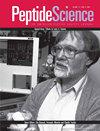Analogs of Cyclic Peptide Mortiamide‐D From Marine Fungi Have Improved Membrane Permeability and Kill Drug‐Resistant Melanoma Cells
IF 1.7
4区 生物学
Q4 BIOCHEMISTRY & MOLECULAR BIOLOGY
引用次数: 0
Abstract
Targeted melanoma therapies, including treatment with the small molecule drug dabrafenib, can become ineffective due to acquired drug resistance. Dabrafenib targets BRAF‐V600E, a mutation that is present in more than half of melanoma cancers. Therefore, drug discovery efforts need to explore alternative candidate molecules that selectively target and kill melanoma cells via mechanisms different to those of current drugs. Marine fungi are an underexplored resource for bioactive molecules. Mortiamide‐D, a seven amino acid cyclic peptide from海洋真菌中的环肽 Mortiamide-D 类似物具有更好的膜渗透性,能杀死耐药性黑色素瘤细胞
包括小分子药物达拉非尼在内的黑色素瘤靶向疗法可能会因获得性耐药性而失效。达拉非尼针对的是 BRAF-V600E,这种突变存在于一半以上的黑色素瘤癌症中。因此,药物研发工作需要探索其他候选分子,通过与现有药物不同的机制选择性地靶向并杀死黑色素瘤细胞。海洋真菌是一种尚未得到充分开发的生物活性分子资源。Mortiamide-D是一种来自Mortierella sp的7个氨基酸环肽,是一种具有药物开发理想特性的示例分子。我们合成了mortiamide-D和三种合理设计的类似物,并观察到它们对HT144黑色素瘤细胞具有适度的微摩尔活性,这些细胞对达拉菲尼敏感或耐药。相比之下,在这些浓度下,吗替麦考酚酯-D 和类似物不能杀死非癌症 HaCaT 细胞。用D-Arg取代第7位的D-Ile可改善膜渗透性,并通过包括扰动线粒体膜电位在内的作用模式增强对HT144细胞的效力。这些研究表明,吗替酰胺具有作为可修饰支架开发新一类靶向黑色素瘤细胞分子的潜力。
本文章由计算机程序翻译,如有差异,请以英文原文为准。
求助全文
约1分钟内获得全文
求助全文
来源期刊

Peptide Science
Biochemistry, Genetics and Molecular Biology-Biophysics
CiteScore
5.20
自引率
4.20%
发文量
36
期刊介绍:
The aim of Peptide Science is to publish significant original research papers and up-to-date reviews covering the entire field of peptide research. Peptide Science provides a forum for papers exploring all aspects of peptide synthesis, materials, structure and bioactivity, including the use of peptides in exploring protein functions and protein-protein interactions. By incorporating both experimental and theoretical studies across the whole spectrum of peptide science, the journal serves the interdisciplinary biochemical, biomaterials, biophysical and biomedical research communities.
Peptide Science is the official journal of the American Peptide Society.
 求助内容:
求助内容: 应助结果提醒方式:
应助结果提醒方式:


